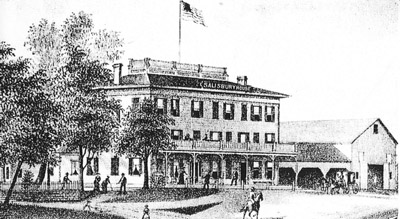Photo: The Salisbury House/Hotel stood on the site of the Sandy Creek Diner, North Main Street
“Salisbury Hotel fire, 1884: A landmark of early Sandy Creek is destroyed by fire!”
Sandy Creek News, November 20, 1884: “As soon as any order could be got out of the chaos, men went to work to stay the progress of the flames. Carpets were spread on the town hall block and bank building (directly across the street) and on Milton Wilder’s house and barn and the pail brigade forwarded water to keep them wet.
|
 |
Wilder’s house which is only 15 feet, was on fire fifty times until the entire end was all blackened, but persistent work saved it, and thus the spread of the conflagration was stopped. A small shop in back of the house was burned. It was also warm work on the town hall block, but the work there was also successful, while the bank building which is of brick escaped with scorched paint and a few broken windows. D. E. Ainsworth removed his library and papers, as did V. C. Washburn and E. L. Sargent took out his safe, but the building was saved and the things put back before morning.”
“The origin of the fire is an unfathomable mystery. The chores were finished at the barn a little after eight o’clock and it was locked, and it seems impossible that fire from a pipe or cigar, as some suggest, could have smoldered so long. About the only reasonable conclusion seems to be that it was of incendiary origin, though any object or motive on the part of anyone is past finding out.”
“The Salisbury House is one of the landmarks of the town there having been a hotel kept there over sixty years. It was built by the father of Frank Salisbury, who ran it until 1846 when he died, and until two years ago Frank has been its landlord and owner. Since then it has been rented to Enos and Saxe, who were the present landlords.”
The Losses: “A low estimate on the hotel and barns is $6,000, with $3,000 insurance, there was no insurance on the furniture belonging to the hotel, although quite a share of it was saved. Enos and Saxe had $1,500 in their furniture and stock, which with what they saved, will make them good. But, the $600 worth of stuff in the barn was a total loss and was not insured. Prof. J. E. Massee who occupied rooms in the hotel was fortunate enough to remove almost all his furniture and books. He had $700 insurance, which will make good all his loans.“
“Misses Wheelock and Burrill, two lady teachers of the school also occupied rooms there, and were fortunate enough to get out about all their goods. George Weaver had $200 insurance on his goods in the house, which will make his loss good. H. A. Hall’s loss falls heavily on him. His building cost him $800 two or three years ago, with only $500 insurance. The loss on stock and furniture, on which there was no insurance, will amount to considerable, besides interrupting his business. Milton Wilder’s household goods were all removed, his house badly damaged by fire and water and a small shop in the rear burned. He was insured for $1,000, which will cover the loss. The fronts of the bank building and town hall blocks were scorched and windows broken probably to the amount of $150 to $200. Mr. and Mrs. Stannard are quite heavily losers, as their household goods were all stored in the hotel, on the third floor and were about all destroyed; loss $800 to $1,000 and no insurance. The insurance ran out the first of this month and was not renewed as they expected to move to Mexico in a few days.”
The article continues: “A good steamer would have saved both the Salisbury House and Hall’s Harness Shop and yet the village seems unwilling to expend one dollar to save five. People were very much slower than usual in getting to the fire, as there was no gong to sound the alarm. The little whistle and church bells did not awaken the citizens. It begins to look as though Sandy Creek intended to lie idly on its oars, as far as fire fighting apparatus is concerned and let the village burn up. At every fire this question is agitated for a time and allowed to die, or is frowned down by a few who ought to encourage the movement to put ourselves in a condition to preserve the property. The time is fast approaching when it will be impossible to get insurance here at any living rate, if we do not bestir ourselves and make better provisions against fire. What is the use of waiting longer until we get scorched again before acting in this matter? If the wind had been blowing in any direction yesterday morning much more property would have been destroyed, and fortune will not always favor us like that. Why not call a meeting forthwith and decide to buy fire apparatus? There is not another village of our size in the state that is as poorly protected as Sandy Creek, and such a state of things ought not to exist.”
|

